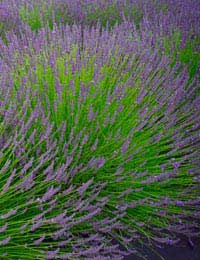Growing lavender is easy and is very rewarding too. It is loved by bees and humans alike and emits a beautiful scent when you brush past it. Lavender is widely grown in British gardens and can have a number of uses in the home and kitchen. The plants can be used for edging beds or grown to form an attractive, low-growing hedge.

Lavender is a native of the Mediterranean but grows well in our cooler climate. It will thrive in a sunny, sheltered position in well-drained soil. The plants can tolerate poor, stony soils and very dry conditions once they are established, but will suffer if kept in damp soil for a long period.
Jump To...
Varieties of Lavender
There are two main types of lavender grown in the UK today:-
- Lavandula stoechas (French lavender) – less hardy, requires a warm, sunny position to thrive. Will tolerate slightly acidic soils.
- Lavandula x intermedia (English lavender) – will tolerate cooler areas and slightly acidic soils.
How to Grow Lavender
Growing lavender is easiest from plants rather than from seed. When planting lavender it’s important to ensure good drainage so the roots are not waterlogged. In poorly drained soils consider adding gravel or organic matter such as well-rotted animal manure or homemade compost to the planting hole to improve drainage. You could also try planting the plants on a raised mound or a ridge, if growing the plants to make a hedge. This will keep the plants’ roots out of saturated soil.
Lavender should be planted in April or May and pruned back to encourage bushy growth. Water them well and continue to water the plants until they are established. Ensure adequate spacing to maintain good air circulation between plants. This prevents a humid environment in warm conditions, which can hamper the plants’ growth. Space plants 90cm apart, or 30cm apart if growing the plants to form a hedge.
Pruning Lavender
Growing lavender should be pruned once a year to keep them in shape. Simply use secateurs to remove the flower stalks and straggly stems. You could also chop the plants back using shears. Snip about 2.5cm off the plants, leaving plenty of green leaves in place. Pruning can either take place in late summer after the plants have finished flowering, or in early spring, before the onset of new growth.
Growing Lavender in Containers
Lavenders grow well in containers but they need large pots as they have long, deep roots. Use a soil-based compost, as this is the closest the plants will get to their natural habitat. Add some old crocks and coarse grit to the base of the container to ensure good drainage. Lavender grown in containers will need watering regularly in summer months, as the pots are prone to drying out. Feed lavender once a week during the growing season with a high-nitrogen organic feed such as seaweed.
Uses for Lavender
Lavender looks great in the garden but it can have many uses in the home too. It is a delicious ingredient in sweet dishes, including biscuits. It can be cut and dried and popped in your pillowcase to aid sleep, or used in dried flower arrangements to give off a wonderful scent to your home.
Whatever uses you have for lavender, it is a fantastic and beautiful herb to grow in the garden. It is easy to grow and looks great in a traditional herb garden, herbaceous border or even as edging for beds.

I have an entire bed of lavender in my garden and it’s wonderful. Brush against it as you go past and suddenly the air smells delicious. However, I’ve never pruned my lavender, and so far it hasn’t been a problem as it hasn’t become overgrown. It’s worth it for the different shades of lavender on the heads and the bees and butterflies who come around to enjoy the plants, as well as the scent.
Is there anyway of keeping English lavender blooming until September. Would a feed of tomorite encourage it to produce more buds. Many thanks